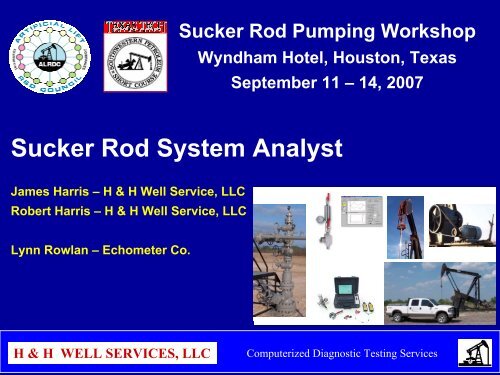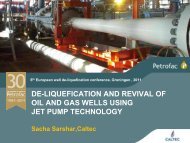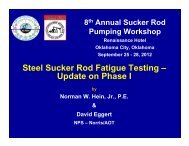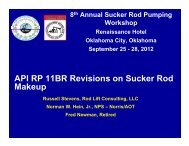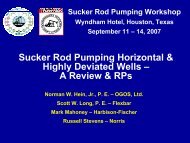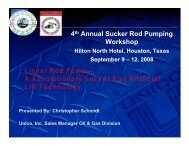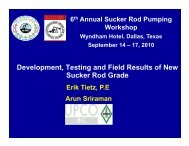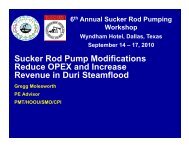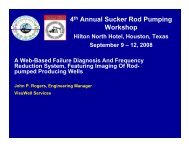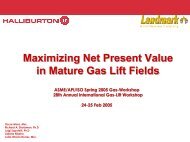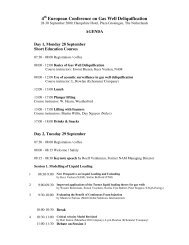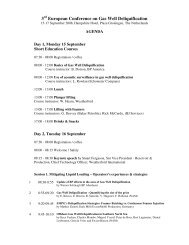Sucker Rod System Analyst - ALRDC
Sucker Rod System Analyst - ALRDC
Sucker Rod System Analyst - ALRDC
You also want an ePaper? Increase the reach of your titles
YUMPU automatically turns print PDFs into web optimized ePapers that Google loves.
<strong>Sucker</strong> <strong>Rod</strong> Pumping Workshop<br />
Wyndham Hotel, Houston, Texas<br />
September 11 – 14, 2007<br />
<strong>Sucker</strong> <strong>Rod</strong> <strong>System</strong> <strong>Analyst</strong><br />
James Harris – H & H Well Service, LLC<br />
Robert Harris – H & H Well Service, LLC<br />
Lynn Rowlan – Echometer Co.<br />
H & H WELL SERVICES, LLC Computerized Diagnostic Testing Services
Role of <strong>Sucker</strong> <strong>Rod</strong> <strong>System</strong> <strong>Analyst</strong><br />
1. Time Requirement is about 45 minutes per well.<br />
2. Analyze collected data at the well.<br />
3. Make recommendations to fix problems discovered.<br />
4. Record work necessary to fix problem as notes.<br />
5. When recommended changes are completed, new data<br />
should be collected once the well has stabilized<br />
6. Notice if well performance changed as planned.<br />
7. Follow-up Follow up on recommendations to learn from<br />
successes and failures.<br />
8. Role changes from a data collector to a knowledgeable<br />
well analyst and problem solver.<br />
Sept. 11 - 14, 2007<br />
2007 <strong>Sucker</strong> <strong>Rod</strong> Pumping Workshop 2
Well Well Analysis Analysis Identifies Identifies the the Problem<br />
Problem<br />
Sept. 11 - 14, 2007<br />
• Inflow Performance<br />
• Pump Performance<br />
• Mechanical Loading<br />
• Prime Mover<br />
• <strong>System</strong> Efficiency Analysis<br />
• Root Cause of Failure<br />
• Data Trends Over Time<br />
– Has Well’s Well s Production Changed?<br />
– Has the Fluid Level Changed?<br />
• Dynamometer<br />
Goal is to answer the WELL PERFORMANCE QUESTIONS<br />
2007 <strong>Sucker</strong> <strong>Rod</strong> Pumping Workshop 3
What Well Information Should be<br />
Known in Order to Analyze a Well?<br />
• Wellbore description<br />
• Artificial Lift <strong>System</strong> Design<br />
• Recent and/or Representative Well Test<br />
• Pump Capacity (or, Pump Card)<br />
• Producing BHP & Static BHP<br />
• Current Production Equipment Setup<br />
• Energy Efficiency<br />
• Fluid Properties<br />
• Past History<br />
Sept. 11 - 14, 2007<br />
2007 <strong>Sucker</strong> <strong>Rod</strong> Pumping Workshop 4
Different Units – Same Info Required<br />
Sept. 11 - 14, 2007<br />
2007 <strong>Sucker</strong> <strong>Rod</strong> Pumping Workshop 5
Record Observations at the Well<br />
Consistency in Approach<br />
• Use Check List<br />
• Motor Info<br />
• PU Info<br />
• Site Condition<br />
• Noticeable Leaks<br />
• Is Fluid going into the<br />
tank<br />
Sept. 11 - 14, 2007<br />
2007 <strong>Sucker</strong> <strong>Rod</strong> Pumping Workshop 6
Key Observations at the Well<br />
• Tubing and Casing Pressure Readings<br />
• Is Produced Fluid Warming the Flow Line<br />
• Is Polished <strong>Rod</strong> Hot to the Touch<br />
• Hear any Unusual Noises at the Well<br />
• Are Belts, Polished <strong>Rod</strong>, or Pumping Unit Shaking<br />
or Vibrating<br />
• Are Downhole Impact Loads Shaking the Ground<br />
• Can the Pump Pressure up the Tubing<br />
• Does this Tubing Pressure Leak Off<br />
Sept. 11 - 14, 2007<br />
2007 <strong>Sucker</strong> <strong>Rod</strong> Pumping Workshop 7
Sept. 11 - 14, 2007<br />
Record what you see<br />
2007 <strong>Sucker</strong> <strong>Rod</strong> Pumping Workshop 8
30.00<br />
25.00<br />
20.00<br />
15.00<br />
10.00<br />
5.00<br />
0<br />
Problem Shown w/ Digital Camera<br />
Wrf + Fo Max<br />
Wrf<br />
Fo Max<br />
-5.00<br />
0 100.0<br />
Sept. 11 - 14, 2007<br />
Dynamometer Cards Appear to be OK<br />
Fo From Fluid Level<br />
74.8<br />
2007 <strong>Sucker</strong> <strong>Rod</strong> Pumping Workshop 9
Sept. 11 - 14, 2007<br />
Normal 7 SPM Slows to 3 SPM<br />
Due to <strong>Rod</strong> Heavy Imbalance<br />
6 Sec 4 Sec<br />
2007 <strong>Sucker</strong> <strong>Rod</strong> Pumping Workshop 10
Sept. 11 - 14, 2007<br />
Common Practices that Result in<br />
Operational Problems<br />
• Need to tag in-order in order to pump.<br />
• Disabled POC Controller - set on hand and<br />
running 24 hrs/day.<br />
• Increase SPM in Order to Maintain Production.<br />
• Increase SPM because Fluid Level is above the<br />
pump.<br />
• Pull the Well, because no Fluid in the Tank.<br />
• Wells Produce into Common Tank, no good test<br />
data.<br />
2007 <strong>Sucker</strong> <strong>Rod</strong> Pumping Workshop 11
ACOUSTIC SURVEYS ANSWER FOLLOWING<br />
QUESTIONS IN ORDER TO ANALYZE A WELL:<br />
1. What is the depth to the top of the liquid?<br />
2. Does liquid exist above the pump?<br />
3. What is the percentage of liquid in the annular fluid<br />
column?<br />
4. Does the liquid in the casing annulus restrict<br />
production?<br />
5. What is the casing-head casing head pressure? Does it restrict<br />
production?<br />
6. Is gas flowing up the annulus? At what rate?<br />
7. What’s What s maximum production rate available from well?<br />
Sept. 11 - 14, 2007<br />
2007 <strong>Sucker</strong> <strong>Rod</strong> Pumping Workshop 12
Wellbore Reflections shown in Fluid Level<br />
Sept. 11 - 14, 2007<br />
1. Acoustic Fluid Level and<br />
Pressure Build-up Build up are used<br />
to answer Questions<br />
2. The Depth from the gun to<br />
an anomaly in the casing<br />
annulus reflect back to the<br />
microphone at the surface.<br />
3. Microphone housed in the<br />
gas gun detects the blast<br />
from the shot and reflected<br />
sound from collars, liners,<br />
perforations, liquid level,<br />
plus other obstructions in<br />
the annulus.<br />
2007 <strong>Sucker</strong> <strong>Rod</strong> Pumping Workshop 13
Acoustic Liquid Level Test Analysis<br />
Sept. 11 - 14, 2007<br />
2007 <strong>Sucker</strong> <strong>Rod</strong> Pumping Workshop 14
DYNAMOMETER SURVEY ANSWER FOLLOWING<br />
QUESTIONS IN ORDER TO ANALYZE A WELL:<br />
1. Is the well pumped off?<br />
2. What is the pump intake pressure?<br />
3. What is the pump fillage? And pump displacement?<br />
4. What is the current pumping speed?<br />
5. Are the traveling and/or standing valves leaking?<br />
6. Are the maximum and minimum rod loads within limits?<br />
7. What is the polished rod and pump horsepower?<br />
8. Gearbox overloaded? Is the unit properly balanced?<br />
9. Required counterweight movement to balance the unit?<br />
10. 0. Is the downhole gas separator effective?<br />
Sept. 11 - 14, 2007<br />
2007 <strong>Sucker</strong> <strong>Rod</strong> Pumping Workshop 15
Use Any of these Transducers to Perform a<br />
Dynamometer Survey<br />
Accurate<br />
Sept. 11 - 14, 2007<br />
Safe &<br />
Quick<br />
2007 <strong>Sucker</strong> <strong>Rod</strong> Pumping Workshop 16
Sept. 11 - 14, 2007<br />
Dynamometer Cards<br />
1) Diagnostic dynamometer<br />
surface cards used for<br />
Diagnosing <strong>Sucker</strong> <strong>Rod</strong><br />
Pumping <strong>System</strong>s.<br />
2) Pump dynamometer card is to<br />
identify and analyze downhole<br />
problems.<br />
3) Spike load at 49.5 inches on<br />
Stroke #20 shows when the<br />
plunger stopped on the<br />
upstroke. Unusual shape<br />
occurs over a 1 second time<br />
period and represents 1850 lb<br />
load increase required to<br />
overcome the downhole friction.<br />
20.00<br />
17.50<br />
15.00<br />
12.50<br />
10.00<br />
7.50<br />
5.00<br />
2.50<br />
0<br />
Wrf + Fo Max<br />
Wrf<br />
Surface Card<br />
Fo Max Fo From Fluid Level<br />
Pump Card<br />
82.6<br />
2007 <strong>Sucker</strong> <strong>Rod</strong> Pumping -2.50 Workshop 17<br />
0 104.7
15 inches of Surface Stroke (73-88 inches on Upstroke)<br />
Lost to <strong>Rod</strong> Stretch in-order to apply Force to overcome<br />
Sudden 1850 lbs of Unknown Friction on <strong>Rod</strong>s and Plunger<br />
Sept. 11 - 14, 2007<br />
Plunger Stop for 1 Second<br />
Plunger Velocity<br />
2007 <strong>Sucker</strong> <strong>Rod</strong> Pumping Workshop 18
Valve Check Load Tests Answer Following<br />
Questions in Order to Analyze a Well:<br />
1. What rate does the Traveling Valve Leak?<br />
2. What is the condition of the traveling valve,<br />
the pump barrel and plunger and the tubing<br />
string?<br />
3. Is the fluid being held in the tubing?<br />
4. Does the Standing Valve Leak?<br />
5. Are the rod string lengths correct?<br />
Sept. 11 - 14, 2007<br />
2007 <strong>Sucker</strong> <strong>Rod</strong> Pumping Workshop 19
Stop on the Down Stroke to Monitor for Leakage<br />
from the Pump into the Casing<br />
Standing valve test taken during the down stroke by<br />
gently stopping about ¼ from the bottom of the stroke.<br />
Sept. 11 - 14, 2007<br />
2007 <strong>Sucker</strong> <strong>Rod</strong> Pumping Workshop 20
Stop on the Upstroke to Monitor for Leakage<br />
from the Tubing into the Pump<br />
TV Check Load Test<br />
TV Check Load Test<br />
weighs the rod string<br />
buoyed in tubing fluid<br />
plus the fluid load<br />
acting on the traveling<br />
valve (across plunger).<br />
Sept. 11 - 14, 2007<br />
2007 <strong>Sucker</strong> <strong>Rod</strong> Pumping Workshop 21
Sept. 11 - 14, 2007<br />
Measured and Computed Valve Loads<br />
TV Load Loss function of Pump-Barrel Pump Barrel Clearances<br />
2007 <strong>Sucker</strong> <strong>Rod</strong> Pumping Workshop 22
On site Power Survey Answer Following<br />
Questions In Order to Analyze a Well :<br />
1. What is the apparent motor current?<br />
2. What is the real motor current?<br />
3. What is the power use during a pump stroke?<br />
4. What is the exact power consumption , KWH/day, $/month,<br />
$/Bbl, etc?<br />
5. Is the motor over/under sized for the load?<br />
6. What is the power factor?<br />
7. Is the Unit electrically balanced?<br />
8. Does the motor performance require more detailed analysis?<br />
9. What is the Torque loading?<br />
10. What movement of the weights is required to electrically<br />
balance the unit?<br />
11. What is total system efficiency?<br />
Sept. 11 - 14, 2007<br />
2007 <strong>Sucker</strong> <strong>Rod</strong> Pumping Workshop 23
1. Acquire:<br />
Sept. 11 - 14, 2007<br />
Power Measurement Equipment<br />
• RMS (thermal) motor current<br />
• Average (real) motor current<br />
• kW during a pump stroke<br />
cycle.<br />
2. Three voltage sensing leads<br />
RIGHT<br />
CENTER<br />
LEFT<br />
3. Two current sensors.<br />
2007 <strong>Sucker</strong> <strong>Rod</strong> Pumping Workshop 24
Electric Electric Power Power (kW) (kW) and and Current Current (Amps)<br />
(Amps)<br />
Input Input to to the the Motor Motor over over the the time time of of One One Pump Pump Stroke<br />
Stroke<br />
Sept. 11 - 14, 2007<br />
<strong>Rod</strong> Heavy – Overloaded Gearbox<br />
Amps<br />
2007 <strong>Sucker</strong> <strong>Rod</strong> Pumping Workshop 25
To To be be a a Successful Successful Well Well <strong>Analyst</strong><br />
<strong>Analyst</strong><br />
• Must Use Data to Determine the<br />
Solution to Well Problem’s.....<br />
Problem s.....<br />
• Needs to look 10,000 feet<br />
down a 3 inch diameter black hole<br />
and “SEE SEE” what is happening ......<br />
• People often think you are a<br />
Wizard<br />
Sept. 11 - 14, 2007<br />
2007 <strong>Sucker</strong> <strong>Rod</strong> Pumping Workshop 26
Sept. 11 - 14, 2007<br />
QUESTIONS?<br />
QUESTIONS?<br />
2007 <strong>Sucker</strong> <strong>Rod</strong> Pumping Workshop 27
Copyright<br />
Rights to this presentation are owned by the company(ies) and/or<br />
author(s) listed on the title page. By submitting this presentation to<br />
the <strong>Sucker</strong> <strong>Rod</strong> Pumping Workshop, they grant to the Workshop,<br />
the Artificial Lift Research and Development Council (<strong>ALRDC</strong>), and<br />
the Southwestern Petroleum Short Course (SWPSC), rights to:<br />
– Display the presentation at the Workshop.<br />
– Place it on the www.alrdc.com web site, with access to the site to be<br />
as directed by the Workshop Steering Committee.<br />
– Place it on a CD for distribution and/or sale as directed by the<br />
Workshop Steering Committee.<br />
Other uses of this presentation are prohibited without the expressed<br />
written permission of the company(ies) and/or author(s) who own it<br />
and the Workshop Steering Committee.<br />
Sept. 11 - 14, 2007<br />
2007 <strong>Sucker</strong> <strong>Rod</strong> Pumping Workshop 28
Disclaimer<br />
The following disclaimer shall be included as the last page of a Technical Presentation or<br />
Continuing Education Course. A similar disclaimer is included on the front page of the <strong>Sucker</strong> <strong>Rod</strong><br />
Pumping Web Site.<br />
The Artificial Lift Research and Development Council and its officers and trustees, and the <strong>Sucker</strong><br />
<strong>Rod</strong> Pumping Workshop Steering Committee members, and their supporting organizations and<br />
companies (here-in-after referred to as the Sponsoring Organizations), and the author(s) of this<br />
Technical Presentation or Continuing Education Training Course and their company(ies), provide<br />
this presentation and/or training material at the <strong>Sucker</strong> <strong>Rod</strong> Pumping Workshop "as is" without any<br />
warranty of any kind, express or implied, as to the accuracy of the information or the products or<br />
services referred to by any presenter (in so far as such warranties may be excluded under any<br />
relevant law) and these members and their companies will not be liable for unlawful actions and any<br />
losses or damage that may result from use of any presentation as a consequence of any<br />
inaccuracies in, or any omission from, the information which therein may be contained.<br />
The views, opinions, and conclusions expressed in these presentations and/or training materials<br />
are those of the author and not necessarily those of the Sponsoring Organizations. The author is<br />
solely responsible for the content of the materials.<br />
The Sponsoring Organizations cannot and do not warrant the accuracy of these documents beyond<br />
the source documents, although we do make every attempt to work from authoritative sources.<br />
The Sponsoring Organizations provide these presentations and/or training materials as a service.<br />
The Sponsoring Organizations make no representations or warranties, express or implied, with<br />
respect to the presentations and/or training materials, or any part thereof, including any warrantees<br />
of title, non-infringement of copyright or patent rights of others, merchantability, or fitness or<br />
suitability for any purpose.<br />
Sept. 11 - 14, 2007<br />
2007 <strong>Sucker</strong> <strong>Rod</strong> Pumping Workshop 29


